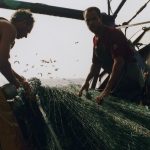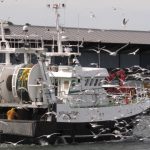U.S. Coast Guardsmen aboard a buoy tender and a C-130 long-range aircraft from Honolulu documented the crew of a vessel believed to be illegally fishing in the protected waters of the Papahanaumokuakea Marine National Monument this past weekend.
A Coast Guard C-130 crew was launched late last week from Air Station Barbers Point on Oahu and located the 79-foot U.S.-flagged long-line fishing vessel believed to be fishing inside the monument Friday, Feb. 27, 2009. The aircraft documented the vessel suspected of having its long-line fishing gear in the water approximately three miles inside the monument and approximately 875 miles from Midway.
The Coast Guard cutter Kukui, an Oahu-based 225-foot buoy tender, was diverted to the fishing vessel’s last-known position in the monument and dispatched a law enforcement team via small boat to board the vessel in order to examine the logs and interview crew members.
The Coast Guard buoy tender’s boarding team gathered evidence that was forwarded to NOAA’s Fisheries Office of Law Enforcement. In the event of a violation, the owner and operator of the vessel may face potential civil penalties and/or permit sanctions.
The monument falls within the Fourteenth Coast Guard District’s area of responsibility and is one of the most remote areas of the world. There are approximately 60 U.S. Fish and Wildlife Service personnel and contractors at Midway and a handful of State of Hawaii and FWS scientists on other small islands, but the Northwestern Hawaiian Islands are mostly uninhabited.
Crews aboard Coast Guard cutters and aircraft conduct routine enforcement and surveillance patrols of the monument while working closely with partner agencies in order to enforce monument regulations and laws.
“The Coast Guard is the primary agency responsible for at-sea enforcement of federal fisheries laws, and we work very closely with our federal and state partners to do that,” said Lt. Cmdr. Jay Caputo, the Fourteenth Coast Guard District’s fisheries enforcement officer. “We are deeply committed to good stewardship of our oceans and protecting the rich and fragile ecosystems of this unique part of the world.”
The monument includes all waters within 50 miles of the islands, reefs and atolls of the Northwestern Hawaiian Islands. This area includes the Midway Atoll National Wildlife Refuge/Battle of Midway National Memorial, the Northwestern Hawaiian Islands State Marine Refuge, the Hawaiian Islands National Wildlife Refuge, the Northwestern Hawaiian Islands Coral Reef Ecosystem Reserve, and Kure Atoll State Wildlife Sanctuary.
“With the combination of training, planning, seamanship and close coordination with our state, federal and international partners, we effectively executed maritime law enforcement this past weekend,” said Caputo. “Preservation of our fragile coral reef environment is paramount to the Pacific’s survival and the U.S. Coast Guard is committed to detecting violators in the Northwestern Hawaiian Islands.”
The maritime area of responsibility for the Coast Guard in the Pacific includes more than 1.5 million square miles of exclusive economic zone (EEZ) areas, eight time zones, and more than 14,000 miles of international boundary line, all of which is threatened by more than 1,200 foreign fishing vessels every day.
On June 15, 2006, former President Bush signed legislation creating the Northwestern Hawaiian Islands Marine National Monument (re-named the Papahanaumokuakea Marine National Monument on March 2, 2007). It is one of the world’s largest fully-protected marine conservation areas.
“Responsible stewardship of the nation’s oceans and waterways is a core Coast Guard mission and one we perform proudly,” said Capt. David Swatland, the Fourteenth Coast Guard District’s Chief of Response and the service’s senior operations officer for the Central and South Pacific.
The Coast Guard’s role in protecting the Papahanaumokuakea Marine National Monument is not limited to law enforcement, notes Swatland. Coast Guard crew members are instrumental on marine debris removal trips and transporting endangered marine mammals.
The Kukui was on a mission to transport an endangered Hawaiian monk seal for NOAA scientists, who released it in the more remote Northwestern Hawaiian Islands because it was becoming overly friendly with people on Lanai.
More than 510 metric tons of debris has been removed from the Northwestern Hawaiian Islands by Coast Guard buoy tenders since 1996, according to Fourteenth District statistics.








